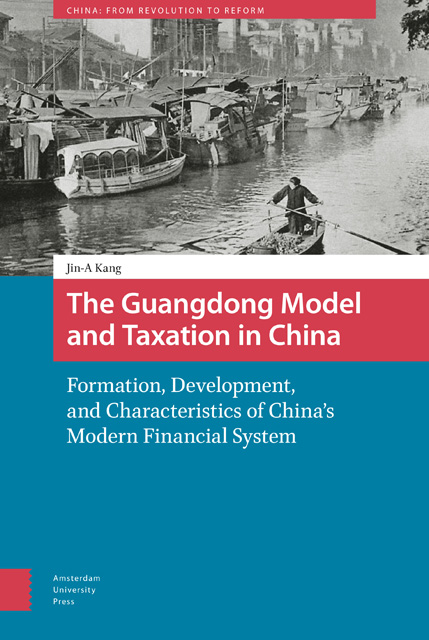 The Guangdong Model and Taxation in China
The Guangdong Model and Taxation in China Book contents
- Frontmatter
- Table of Contents
- Abbreviations
- Acknowledgments
- Introduction: The Modern Transformation of the Imperial Fiscal System: The Case of Provincial Finance in Guangdong
- Part 1 New Tax Revenues in Guangdong during the Republican Era
- Part 2 State-led Industrialization and the State Monopoly
- Part 3 Reform of Tax Collection
- Part 4 The Transition of the Modern Chinese Tax Structure in a Global Context
- Bibliography
- Glossary
- Index
5 - Industrial Building: Provincial Entrepreneurs
Published online by Cambridge University Press: 10 January 2023
- Frontmatter
- Table of Contents
- Abbreviations
- Acknowledgments
- Introduction: The Modern Transformation of the Imperial Fiscal System: The Case of Provincial Finance in Guangdong
- Part 1 New Tax Revenues in Guangdong during the Republican Era
- Part 2 State-led Industrialization and the State Monopoly
- Part 3 Reform of Tax Collection
- Part 4 The Transition of the Modern Chinese Tax Structure in a Global Context
- Bibliography
- Glossary
- Index
Summary
Abstract
The construction of state-owned enterprises is one of the outstanding characteristics of Guangdong finance in the 1930s. Chapter 5 focuses on the Three-year Plan for the Rejuvenation of the Sugar Industry in Guangdong. With the most significant amount of invested capital among government factories, building modern sugar refineries was most successful. To protect the government sugar mills, the Guangdong provincial government followed an import substitution policy to impose the Special Tax on Sugar Imports, which became a significant revenue source. However, the largest profits came from the sugar monopoly that began in 1934. Like the traditional salt monopoly, the government took control of local sugar products and control over the distribution of imports for sales by licensed merchants.
Keywords: Sugar, Guangdong, the Great Depression, monopoly
The construction of state-owned enterprises is one of the outstanding characteristics of Guangdong finance in the 1930s. Although there was some building of provincial government industries in the late Qing, the building of government industries during the Three-Year Administrative Plan (1933–1936) represented a significant success. In terms of the scale of investment and profits, Guangdong's building of twenty-four government factories was the biggest project in China in the 1930s. This chapter focuses on the construction of sugar refineries to analyze China's financial and fiscal strategy during this period. With the greatest amount of invested capital among government factories, the project to build modern sugar refineries was most successful. To protect the government sugar mills, the Guangdong provincial government (hereafter, the GPG) followed an import substitution policy to impose the Special Tax on Sugar Imports, which also became a significant source of revenue. The largest profits, however, came from the sugar monopoly that began in 1934. Like the salt monopoly, a major tax source in traditional China, the GPG took control not only of provincial sugar products but also control over the distribution of imports for sales by licensed merchants.
- Type
- Chapter
- Information
- The Guangdong Model and Taxation in ChinaFormation, Development, and Characteristics of China's Modern Financial System, pp. 139 - 154Publisher: Amsterdam University PressPrint publication year: 2022
